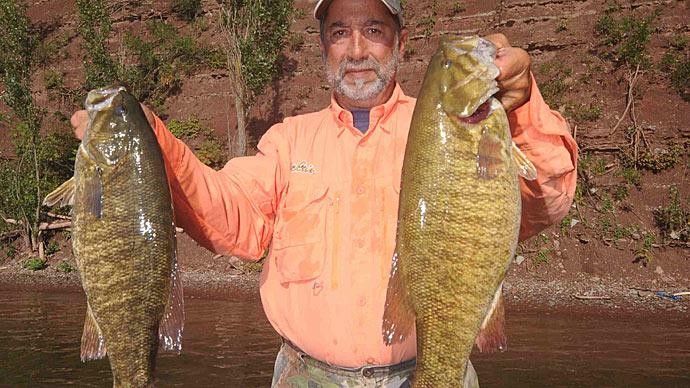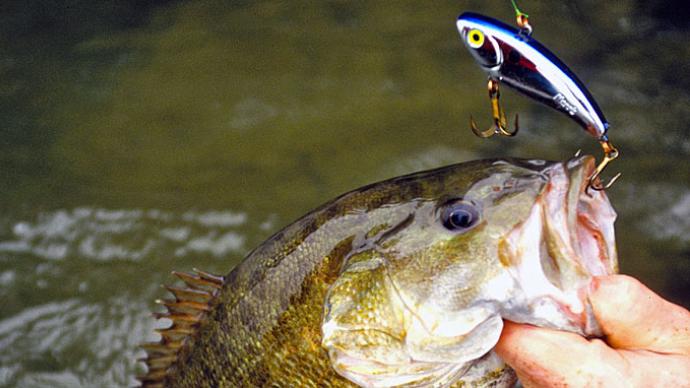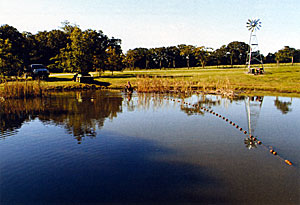
As you might recall, last year about this time we drained and seined a small pond here at Lusk Lodge, 2. The mission was to take the mini-pond, change habitat to what should work for smallmouth bass and see what might happen. The pond was filled with water from our well and then stocked with about forty pounds of crawfish and about 100 4-6 inch smallmouth bass from Kansas. Thirty pounds of fathead minnows were added about two weeks later.
We thought we eradicated all the bluegill in the remaining shallow puddle, but a few made it through... we saw them when we started feeding the fish in March. Fathead minnows came to the feeder, but before long, we saw the telltale splashes of those remaining bluegill.
In April, the little pond was ringed out about ten feet with floating mats of dead algae, so we stocked ten pounds of tilapia, just to see what would happen. I thought their babies would make good forage for our little bass and tilapia could offer control of algae without the need for herbicides.
We've endured the hottest Texas summer since 1980. With scorching temperatures and a seemingly ever-present mat of algae, I was cautiously optimistic about this little fishery. One advantage we've had is that water well.
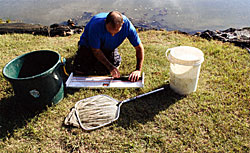
To keep another important pond full of water downstream, we've had occasions to run cool water through this pond, helping to temper some of the hottest days by compensating for evaporation on the rest of the property. Nonetheless, that little pond saw at least thirty days of temperatures into the low 90's.
Plump, fat, healthy fish.
There are two quarter-acre hatchery ponds adjacent to this little experimental pond. Several times this year, we've opened the valves of the two hatchery ponds, which drain directly into our smallie pond.
Fast forward to today, October 1. Staff biologist Josh Flowers and I decided to pull a seine and sample the little fishery. Actually, I've been chomping at the bit to take a look-see and recent cool temperatures, plus a deadline to file this story has been motive enough.
Besides, several times recently, I watched bass flush baitfish into the rocks around the edges of the pond.
We pulled the seine around most of the pond (there are some cattails we skipped around), caught several hundred pounds of fish, mostly tilapia and bluegill. But, we did catch 8 bass.
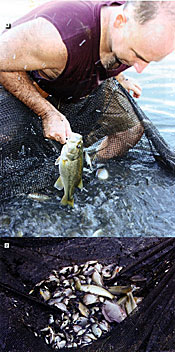
Take a quick look at the photos and then come back to the story.
Plump, fat, healthy fish.
Don't they look great?
Look again.
Those are not smallmouth bass.
They are fat, sassy feed-trained largemouth bass that must have escaped from the south hatchery pond, via the drain pipe, when we were exchanging water from those adjacent ponds.
It's the only explanation I can think of for their presence.
What about the smallies?
As I write, I'm scratching the proverbial head and shrugging at the same time.
We collected not one smallmouth bass.
Not one.
Never saw a dead fish all year, never had an inkling of their disappearance or demise.
There was no catastrophic event, no floating bodies during summer.
Nothing.
Last February, we caught a few of the little smallies, just to see how they looked. They looked pretty good...not as thick as I thought they would be, but quite healthy.
The largemouth bass couldn't have entered the picture until May. They were six inches long when stocked into the adjacent south hatchery pond at that point. The smallies should have been larger than six inches by then.
To me, that means the largemouth bass didn't eat the smallmouth bass.
But, boy did those largemouth bass grow like little hotcakes.
From six inches to 11-12.5 in fairly short order.
What will we do next?

I'm thinking about it. We'll drain the pond, remove the fish and come up with a good plan. Right now, I'm thinking we do it again... try the smallmouth once more just to see if we had some kind of anomaly that I missed or to simply conclude they won't live in this shallow Texas pond. We've added wind-driven aeration. We'll change the way the water enters the pond from the well. We'll change the way water enters from the hatchery ponds and how it leaves the experimental pond.
We've got a few months to decide what to do with that little hole of water.
Draw your own conclusions from our little experiment, but don't use this experiment as basis for you to decide not to try smallmouth bass.
Every pond is different, every management style varies.
That's what has me scratching my head. Was it our management style? Was it fresh well water with no oxygen in it? Was it hot, hot temperatures and too much algae? Did the smallmouth leave through the overflow pipe and go downstream, themselves?
I honestly don't know.
We'll sample the ponds downstream and see if we find any signs, but that won't be until mid-winter.
Until then, stay tuned.
My fisheries biologist gut tells me there will be more to this story.
Reprinted with permission from Pond Boss Magazine

